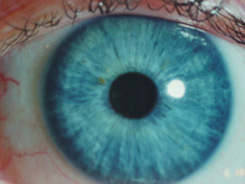 |

 |
Iridology
“The Eyes Are The Windows To The Body, Mind and Soul.”
Iridology is the science and practice of analyzing the iris, the colored portion of the eye that surrounds the pupil. It can reveal detailed health information including the levels of health, inflammation, toxicity, and degeneration in the human body. Iridology provides a painless and economical means of assessing the body’s health imbalances aiding in preventive health care. It may be used with any other diagnostic and treatment modality.
 Iridology may be a new term to some people, but it’s an old practice that dates back to ancient records in China. These records show a form of iris interpretation that was used as far back as 1000 BC, over 3,000 years ago. Iridology has made a lot of forward progress in the last 200 years, and has been used by many doctors and naturopaths worldwide. The pioneering doctor of Iridology in the U.S. is the late Dr. Bernard Jenson. He developed one of the most comprehensive iris charts used today. Many iridologists have expanded on his groundbreaking work.
Iridology may be a new term to some people, but it’s an old practice that dates back to ancient records in China. These records show a form of iris interpretation that was used as far back as 1000 BC, over 3,000 years ago. Iridology has made a lot of forward progress in the last 200 years, and has been used by many doctors and naturopaths worldwide. The pioneering doctor of Iridology in the U.S. is the late Dr. Bernard Jenson. He developed one of the most comprehensive iris charts used today. Many iridologists have expanded on his groundbreaking work.
It is said that the eyes are the windows to the Body, Mind and Soul. Iridology allows us to take the veils off those windows and see what is truly going on inside. The iris, the most complex external structure of the human anatomy is connected to every organ, gland, and tissue of the body via the nervous system. Because the eyes are actually outcrops of brain tissue, the iris is able to gather information about the body, its systems and functioning.
The iris can alert us to the early signs of approaching “dis-ease.” Iridology can tell us a person’s genetic predisposition to health and disease, and points to constitutional strengths and weaknesses. It can indicate the state of organs, glands and tissues and show the results of stress, toxic accumulations, digestive and bowel health, and much more. Iridology can also be used to assess thought and emotional patterns.

As the body adjusts to a more optimum state of health, the eyes can also show us signs of cleansing and healing. By presenting an over-all picture of your physical and emotional health, Iridology can be an invaluable source of information and prevention. This information can be used to design a personalized health program that will strengthen and protect both your health and well-being.
What Can Iridology Reveal?
The primary nutritional needs of the body. |
Hyperactivity or hypoactivity of organs. |
Inherently strong or weak organs, glands, and tissues |
Buildup of cholesterol and inorganic salts. |
Genetic strengths and weakness. |
Buildup of toxic settlements in organs and tissues. |
What organ is in greatest need of repair and rebuilding. |
Prolapse of the transverse colon. |
Difficulties digesting and absorbing carbohydrates, fats, proteins, and sugars. |
Spasms, strictures, sluggishness, pocketing, ballooning, inflammation of the bowel. |
The need of HCL, Pepsin, Enzymes |
High risk tissue areas in the body that may lead to disease. |
Poor assimilation and absorption of nutrients and minerals. |
Lymphatic system congestion. |
Adrenal exhaustion. |
Thought and emotional patterns. |
Depletion of minerals and ability of organ, gland, or tissue to hold minerals and nutrients. |
Location and stages of tissue inflammation, acidity and supression whether acute, sub-acute, chronic, or degenerative. |
Results of physical or mental fatigue or stress on the body. |
Tissue areas contributing to suppressed or buried symptoms. |
Recuperative ability and resistance to disease. |
The need for acidophilus in the bowel. |
Pre-disposition for Diabetes, Heart Disease, Arthritis, Alzheimers. |
Genetic influence on any symptoms present. |
Effects of toxins in the environment. |
Need for rest to build up immunity. |
Circulation level in various organs and pressure on the heart. |
Nervous system strength and nerve depletion. |
As an Iridologist, Kelley uses a specialized camera to perform her iris analysis. She evaluates the images and looks for indicators of genetic strengths and weakness, as well as possible accumulations, such as: over acidic body pH, cholesterol/inorganic plaque build-up, toxic accumulations, mucus or lymphatic congestion, uric acid build up and nutritional and digestive needs.
Please see Consultations page for a conclusive description of how Iridology is integrated into your personal preventive health care consultation, and to schedule an appointment with Kelley.




